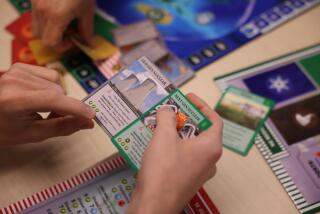Making peace
- Share via
It’s only 11 a.m., but in Ms. Mohn’s second-grade classroom, a lazy, hazy, afternoon calm seems to have descended early. As white sunlight pours through the windows, the students gather in a scattered circle beneath a giant blackboard. Pasted above them is a construction-paper pot, of the sort usually spotted at the end of rainbows. Two college-age women are standing beside it, filling it steadily with gold construction paper coins. Each of these coins is inscribed with a description of a good deed someone in class has witnessed over the past week.
“A boy gave me a paper to draw on,” reads one of the women, placing the corresponding coin into the pot. She holds up another and squints to read the description.
“My brother,” she says, “picked me up when I fell down.”
And another. “Someone was sharing hot Cheetos!”
The class squeals in delight as the coins pile higher and higher.
This group of youngsters, at Mayo Elementary School in Compton, is taking part in an experimental program called Peace Games, an on-site educational undertaking that teaches kids about friendship, feelings and effective communication.
“The basic concept is to build a culture of peacemaking,” says the program’s founder, Eric Dawson. “We started with the idea of, what would our country look like if the way we tried to prevent violence was trying to promote peace and justice? In other words, what would it look like if every kid had the knowledge and the awareness to be able to cooperate and communicate and resolve conflicts without fighting?”
At Mayo Elementary, this knowledge seems to be taking hold, in Dana Mohn’s room, where acts of kindness are uniquely celebrated, and later, in a third-grade class, where students adeptly playact various methods of communication.
“We’re trying to prepare a generation of leaders,” Dawson explains, “giving them skill sets not only to be successful, but to be good, thoughtful and caring people.” Dawson began his own quest for social change early on, establishing, while still in high school, an organization that fought for equal rights for special ed students.
Peace Games began to take shape in 1992, as a one-day festival inspired by the late Dr. Francelia Butler, a professor of children’s literature at the University of Connecticut. Dawson began expanding on the idea after he graduated from Harvard, and now Peace Games is a nationwide nonprofit organization funded by grants and private donations.
Bringing the concept into schools seemed like a logical step, Dawson explains.
“It’s always been complicated because we have a culture that has a tremendous amount of violence,” he says. “There are studies that estimate that by the time a child finishes first grade he has witnessed a thousand acts of violence. You heard so much about how kids were victims and perpetrators of violent crime, but what was missing for me was the idea that young people are also the peacemakers, and every day in this country, there are children doing good things, kids involved in their communities. So what if you highlighted that?
“And, an even more audacious question, what would it look like if schools became an engine for this kind of work?”
The program is in 12 schools nationwide (including L.A.’s Norwood Street and John Muir elementary schools, in addition to Mayo), each maintaining a full-time Peace Games staffer.
At Mayo Elementary, that person is Minerva Chavez, the site’s director and overseer of a crew of volunteers, most culled from the education programs at USC and Cal State Long Beach.
“We work with the kids three days a week, an hour a day,” Chavez says. “We focus on feelings with the first-graders, on friendship with the second-graders and on communication with the third-graders. Overall it’s been an amazing experience.”
Luis Sanchez, who teaches first grade at Mayo, agrees. “What Peace Games has given the kids is a vocabulary to communicate their feelings, to explain why they’re angry or sad,” he says. “Now, they know that they have choices, and they know that if there’s a problem, there’s a way to fix it.”
What the kids really seem to be learning, is, quite simply, how to be nice.
“I think social change and social justice is lived in the daily,” Dawson says. “It’s not the big, broad, brush strokes, it’s the small details. Peace doesn’t have to be this big, abstract theory. It’s just thinking about what makes a good person.... I don’t think we spend enough time thinking about the kind of children we want to create for our world.”
*
Peace Games
Program information: www.peacegames.org
Jessica Hundley can be reached at weekend@latimes.com
More to Read
Sign up for Essential California
The most important California stories and recommendations in your inbox every morning.
You may occasionally receive promotional content from the Los Angeles Times.










